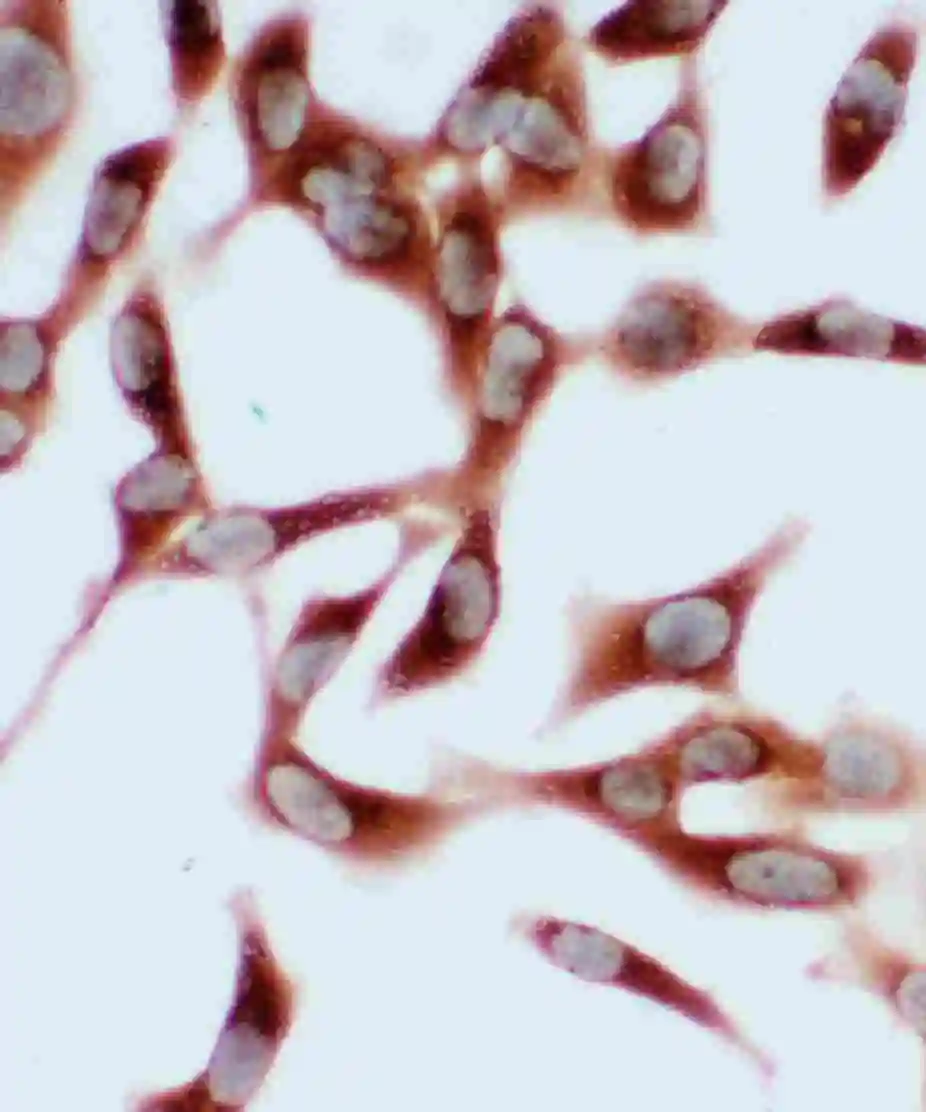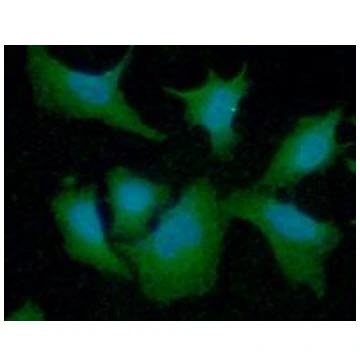Hsp70 antibody
GTX111088
ApplicationsImmunoFluorescence, ImmunoPrecipitation, Western Blot, ImmunoCytoChemistry, ImmunoHistoChemistry, ImmunoHistoChemistry Paraffin
Product group Antibodies
TargetHSPA1A
Overview
- SupplierGeneTex
- Product NameHsp70 antibody
- Delivery Days Customer9
- Application Supplier NoteWB: 1:5000-1:20000. ICC/IF: 1:100-1:1000. IHC-P: 1:100-1:1000. IP: 1:500-1:1000. *Optimal dilutions/concentrations should be determined by the researcher.Not tested in other applications.
- ApplicationsImmunoFluorescence, ImmunoPrecipitation, Western Blot, ImmunoCytoChemistry, ImmunoHistoChemistry, ImmunoHistoChemistry Paraffin
- CertificationResearch Use Only
- ClonalityPolyclonal
- Concentration0.62 mg/ml
- ConjugateUnconjugated
- Gene ID3303
- Target nameHSPA1A
- Target descriptionheat shock protein family A (Hsp70) member 1A
- Target synonymsHEL-S-103, HSP70, HSP70-1, HSP70-1A, HSP70-2, HSP70.1, HSP70.2, HSP70I, HSP72, HSPA1, heat shock 70 kDa protein 1A, HSP70-1/HSP70-2, HSP70.1/HSP70.2, Heat shock 70 kDa protein 1B, Heat shock 70 kDa protein 2, dnaK-type molecular chaperone HSP70-1, epididymis secretory protein Li 103, epididymis secretory sperm binding protein, heat shock 70 kDa protein 1, heat shock 70 kDa protein 1/2, heat shock 70 kDa protein 1A/1B, heat shock 70kD protein 1A, heat shock 70kDa protein 1A, heat shock protein family A member 1A, heat shock-induced protein
- HostRabbit
- IsotypeIgG
- Protein IDP0DMV8
- Protein NameHeat shock 70 kDa protein 1A
- Scientific DescriptionThis intronless gene encodes a 70kDa heat shock protein which is a member of the heat shock protein 70 family. In conjuction with other heat shock proteins, this protein stabilizes existing proteins against aggregation and mediates the folding of newly translated proteins in the cytosol and in organelles. It is also involved in the ubiquitin-proteasome pathway through interaction with the AU-rich element RNA-binding protein 1. The gene is located in the major histocompatibility complex class III region, in a cluster with two closely related genes which encode similar proteins. [provided by RefSeq]
- Storage Instruction-20°C or -80°C,2°C to 8°C
- UNSPSC12352203
References
- Heat Shock Protein Family A Member 1 Promotes Intracellular Amplification of Hepatitis B Virus Covalently Closed Circular DNA.Read more
- Heat shock factor 1 suppression induces spindle abnormalities and sensitizes cells to antimitotic drugs. Kuo HH et al., 2021 Dec 18, Cell DivRead more
- Aged Skeletal Muscle Retains the Ability to Remodel Extracellular Matrix for Degradation of Collagen Deposition after Muscle Injury. Chen WJ et al., 2021 Feb 20, Int J Mol SciRead more
- Proteomic analysis of Antrodia Cinnamomea-induced ER stress in liver cancer cells. Chen JF et al., 2020 Aug 5, J Pharm Biomed AnalRead more
- Knocking out C9ORF72 Exacerbates Axonal Trafficking Defects Associated with Hexanucleotide Repeat Expansion and Reduces Levels of Heat Shock Proteins. Abo-Rady M et al., 2020 Mar 10, Stem Cell ReportsRead more
- Rrm2b deletion causes mitochondrial metabolic defects in renal tubules. Chen YF et al., 2019 Sep 13, Sci RepRead more
- Baculovirus IE2 Stimulates the Expression of Heat Shock Proteins in Insect and Mammalian Cells to Facilitate Its Proper Functioning. Tung H et al., 2016, PLoS OneRead more
- Expression patterns and structural modelling of Hsp70 and Hsp90 in a fish-borne zoonotic nematode Anisakis pegreffii. Chen HY et al., 2015 Sep 15, Vet ParasitolRead more
- Characterization and binding analysis of a microneme adhesive repeat domain-containing protein from Toxoplasma gondii. Gong H et al., 2014 Apr, Parasitol IntRead more

![IHC-P analysis of human prostate carcinoma tissue using GTX22787 Hsp70 antibody [5A5]. Left : Primary antibody Right : Negative control without primary antibody Antigen retrieval : heat induced antigen retrieval was performed using 10mM sodium citrate (pH6.0) buffer, microwaved for 8-15 minutes Dilution : 1:100](https://www.genetex.com/upload/website/prouct_img/normal/GTX22787/GTX22787_1110_IHC-P_w_23060620_738.webp)
![IHC-P analysis of human breast carcinoma tissue using GTX25439 Hsp70 antibody [3A3]. Left : Primary antibody Right : Negative control without primary antibody Antigen retrieval : heat induced antigen retrieval was performed using 10mM sodium citrate (pH6.0) buffer, microwaved for 8-15 minutes Dilution : 1:50](https://www.genetex.com/upload/website/prouct_img/normal/GTX25439/GTX25439_1283_IHC-P_w_23060722_400.webp)
![IHC-P analysis of human prostate carcinoma tissue using GTX25442 Hsp70 antibody [2A4]. Left : Primary antibody Right : Negative control without primary antibody Antigen retrieval : heat induced antigen retrieval was performed using 10mM sodium citrate (pH6.0) buffer, microwaved for 8-15 minutes Dilution : 1:200](https://www.genetex.com/upload/website/prouct_img/normal/GTX25442/GTX25442_1286_IHC-P_w_23060722_618.webp)
![IHC-P analysis of human prostate carcinoma tissue using GTX25444 Hsp70 antibody [4G4]. Left : Primary antibody Right : Negative control without primary antibody Antigen retrieval : heat induced antigen retrieval was performed using 10mM sodium citrate (pH6.0) buffer, microwaved for 8-15 minutes Dilution : 1:20](https://www.genetex.com/upload/website/prouct_img/normal/GTX25444/GTX25444_1289_IHC-P_w_23060722_635.webp)

